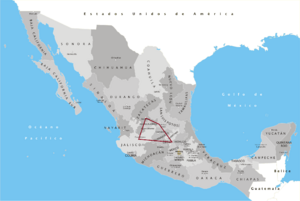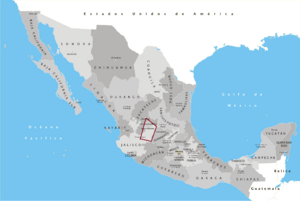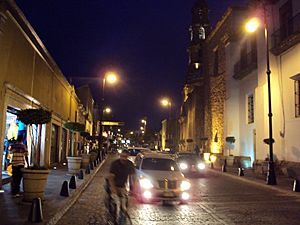Bajío facts for kids
The Bajío (pronounced Bah-HEE-oh) is a special region in Central Mexico. The name means "lowlands." It includes parts of the states of Aguascalientes, Jalisco, Guanajuato, and Querétaro.
This area is often called one of the best places to live in Mexico, and sometimes even in Latin America. It's known for being safe and having a strong, growing economy, especially in service industries. The biggest cities in the Bajío are Guadalajara, León, Santiago de Querétaro, and Aguascalientes.
Contents
History of the Bajío
Long ago, from about 300 to 650 CE, a unique culture thrived in the Bajío region. This "Bajío Culture" lived along the Lerma and Laja rivers. Archaeologists have found over 1,400 ancient sites in Guanajuato alone! Some important sites that have been studied a lot include Cañada de la Virgen, El Cóporo, Peralta, and Plazuelas.
Later, this region was known as La Gran Chichimeca. It was a very important place during the Mexican War of Independence, where Mexico fought to become free from Spain.
Geography of the Bajío
The Bajío is often thought of as the states of Guanajuato and Querétaro, even though it covers more than just those two. This region is famous for its modern farming. It gets a good amount of rain, about 700 millimeters (27.5 inches) each year, which is a lot for Mexico.
In the past, during the time of New Spain, the Bajío was called the "breadbasket" because it grew so much food. Today, it still produces a lot of crops like sorghum, wheat, and maize (corn). The Bajío region is located in the river basins of the Rio Lerma and Río Grande de Santiago.
States in the Bajío
The Bajío region includes parts of these four states:
| Aguascalientes | Guanajuato | Jalisco | Querétaro |
 |
 |
 |
 |
| Aguascalientes | Guanajuato | Guadalajara | Querétaro |
Cities in Aguascalientes
Cities in Guanajuato
Cities in Jalisco
- Guadalajara
- Lagos de Moreno
- Tepatitlán de Morelos
- San Juan de los Lagos
- Arandas
Cities in Querétaro
- Santiago de Querétaro
- San Juan del Río
People and Cities
The Bajío region is growing very fast. Many people from other parts of Mexico are moving here because of the job opportunities and good quality of life.
Largest Cities in the Bajío
Here are some of the biggest cities in the Bajío region by population:
| Rank | City | State | Population | Metro Area |
|---|---|---|---|---|
| 1 | Guadalajara | Jalisco | 1,530,817 | 4,664,212 |
| 2 | León | Guanajuato | 1,436,480 | 1,609,717 |
| 3 | Aguascalientes | Aguascalientes | 934,424 | 1,025,432 |
| 4 | Santiago de Querétaro | Querétaro | 801,940 | 1,097,025 |
| 5 | Irapuato | Guanajuato | 380,941 | 529,979 |
| 6 | Celaya | Guanajuato | 310,413 | 468,387 |
| 7 | Salamanca | Guanajuato | 160,169 | 260,732 |
| 8 | Lagos de Moreno | Jalisco | 153,817 | 164,212 |
| 9 | San Juan del Río | Querétaro | 138,878 | 402,112 |
| 10 | Tepatitlán de Morelos | Jalisco | 104,377 | 288,635 |
| 11 | Silao | Guanajuato | 74,242 | 147,123 |
Economy and Growth
The Bajío is one of the fastest-growing regions in Mexico. This strong growth has led to higher incomes for people living here. Many companies, especially from other countries, are investing in the area.
The Bajío is also home to several World Heritage Sites, which are places recognized by UNESCO for their special cultural or historical importance. These sites attract many tourists and new residents.
Some World Heritage Sites in or near the Bajío include:
- San Miguel de Allende
- Sanctuary of Jesús Nazareno de Atotonilco
- Franciscan Missions in the Sierra Gorda
- Agave Landscape and Ancient Industrial Facilities of Tequila
- Hospicio Cabañas
- Guanajuato City
- Zacatecas City
- Querétaro City
Asian Communities
The Bajío region has seen a growing number of people from Asia, especially Japanese and Koreans. This is because many foreign companies, particularly in the car industry, are opening factories and offices here.
By 2014, there were over three thousand Japanese people living in the Bajío. The government of Guanajuato expected this number to grow even more. In Querétaro, many Japanese restaurants have opened, and there are even talks about a Japanese school opening a campus there. A Japanese-language newspaper, Bajío Shimbun, started in 2015. In 2016, the first Japanese consulate in Mexico opened in León to serve the Bajío region.
The Korean community is also growing for similar reasons, with more Korean students attending private schools in the area.
Future of Transportation
There are plans to build a high-speed train that would connect Querétaro to Mexico City and then continue to Guadalajara. This train would make it much easier and faster to travel between the major cities in the Bajío region.
Culture and History
The Bajío is known for being the birthplace of Mexico's independence movement from Spain. It is also a very important area for Mexican Catholicism.
During the Mexican Revolution, a major battle happened in the Bajío in April 1915. General Álvaro Obregón fought against Pancho Villa's troops near Celaya, and Villa's forces lost in June.
Images for kids
See also
 In Spanish: Bajío (México) para niños
In Spanish: Bajío (México) para niños




